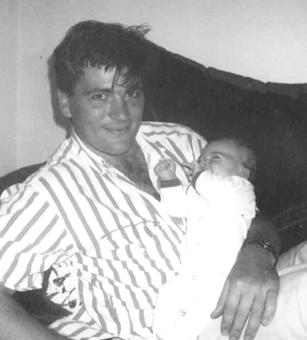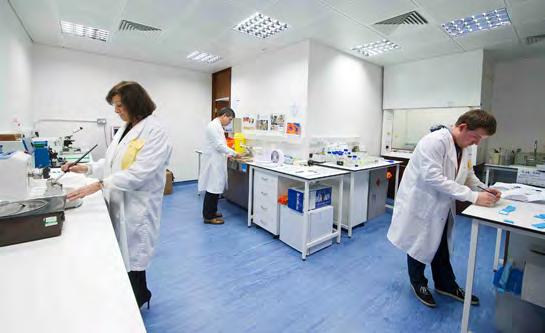
7 minute read
The impact of CRY's Centre for Cardiac Pathology on grieving families
By Alison Cox MBE (CRY Founder)
I don’t think that anything has had a greater impact on reducing suffering for our bereaved families than when we set up our unique Centre for Cardiac Pathology (CRY CCP).
Prior to this innovative development the length of time that a grieving family had to wait to find out what had killed their apparently fit and healthy child or partner could take anything from several weeks to 18+ months. This was because there were very few pathologists that understood young sudden cardiac death (YSCD) in the 1990s.
The genetic implications were only just beginning to be understood and the prevailing attitude often seemed to be that there was no rush, because the young person was dead and identifying the cause of death was just a matter of completing the required process. Because it was believed that these conditions were very rare and inexperienced pathologists did not recognise the dangerous abnormalities that were killing fit and healthy young people, there was little urgency, understanding or indeed interest in YSCD.

One of our first supporters, Caroline Gard (above, second from right), explained: “When Andy (above, right) died 20 years ago, it was a complete shock as we had no warning or awareness that he might have had anything wrong with him at all, least of all a heart problem. In those very dark and dreadful early days after his death, when we were completely shell shocked, we had absolutely no idea what had happened and what had caused this so suddenly. We found ourselves asking how it could be that someone so seemingly ‘fit and healthy’ could possibly just die for no apparent reason – even our GP friends were unable to offer us any answers.
“It took several weeks for the pathologist to come up with his findings. Eventually the official cause of death given was a myocardial infarction. At the time we knew this might serve as an official answer, although in reality it gave us no comfort, as in no way did it address the reason why this may have occurred.
“In truth it made no sense to us but we felt powerless and lacking in energy to fight for more information. This is something that haunts us still today. We felt we had nowhere to turn for the help and advice we needed – it seemed as though the cause of death had been established for official purposes and we had no choice but to accept it with no consideration for our doubts or desire for elaboration. We had not yet heard of CRY.”
Not having any guidance of what had happened to strike dead their apparently fit and healthy child or partner meant that families were not only traumatised, but also left dangerously in Limbo and at serious risk of another sudden death. CRY’s battle at that time was to raise awareness both of the danger of these potentially genetic conditions and the importance of expert pathology which identified whether or not further family testing was required.
Pathology is only useful if it can be purposefully acted upon, but the additional anguish, after their tragedy, for a mother to learn that she could be the carrier of a genetic condition that had killed her child was often too much to bear. Consequently, she was sometimes unable to confront being screened herself, although she would usually support getting any other child/children screened. This was not only treacherous for her family but further inhibited progress, as did the fact that there was no dedicated facility that offered family screening.
CRY’s first fundraising donation of £10,000 in 1995 was to St George’s for the down payment which secured the acquisition of an echocardiogram for the dedicated use of families at risk of the genetic condition cardiomyopathy –the main known cause at that time of YSCD. As a result the St George’s centre was the first to be able to offer screening for all family members together.
When Howard English died in 1993, aged 32, playing rugby, his wife, Stephanie, was emphatically reassured that Howard’s death was due to a faulty mitral valve. The pathologist insisted that the family were not at risk of a genetic condition. The shock of her eldest child, Sebastian, dying while playing rugby at the age of 15, 11 years after his father caused her indescribable suffering. This time the pathology was correctly diagnosed as cardiomyopathy by Mary Sheppard, who had built up extensive experience in YSCD with Professor Michael Davies, a leader in this relatively unknown field and a trail-blazing pioneer.

Howard and Sebastian English
The family then found CRY and embarked on an extraordinary fundraising campaign supported by friend (subsequently one of our Patrons) Simon Halliday, who had been coaching the rugby team that Howard had been playing in when he died. Simon master-minded the launch of the Howard and Sebastian English memorial fund with the Bath Half Marathon in 2006 and was supported by many of the golden oldies of rugby which raised not only considerable awareness in the press, but also in excess of £100,000.

CRY Patron Simon Halliday, standing second from the right, at the Bath Half Marathon
The enormous generosity of family and friends over many years led to the launching of the CRY Centre of Cardiac Pathology in 2004 in memory of Howard and Sebastian. Mary Sheppard says: “I was very pleased to have the opportunity of meeting Stephanie and Rupert and discussing with them the prospect of my leading the unit which has proved to be so hugely important in CRY’s work to reduce the suffering of bereaved families.”
Coroners were appreciative with the new CRY-funded fast- track service we were then able to provide for them which made a significant difference – not only to being able to give the family a specific cause of death, but also enabling coroners to close their investigation conclusively and more swiftly than had been possible in the past when they were completely dependent on the waiting time that the pathologist required.
The impact of having a dedicated centre for the pathology of victims of YSCD cannot be overestimated. CRY’s service endeavoured to return the heart to the family in time for the funeral and as a result of this families were no longer reluctant to have their child or partners heart sent away for examination, which was so critical to understanding whether another family member could be at risk of having an inherited condition. The significance of this breakthrough meant that families were able to alert their cardiologist to the condition that caused their tragedy, dramatically reducing the risk of another family member dying.

Unlike many pathologists who often seemed reluctant to communicate with affected families, Mary Sheppard (now Professor Sheppard, above) favoured speaking to the bereaved parent if this was requested. She was pleased to help them understand the cause of death and benefited from being able to discuss the circumstances of the death and whether there was any family history. The considerable experience Mary has now accumulated in this very specialist field has resulted in frequent demands to lecture at international conferences. An unfortunate consequence of this means her ambitious ‘time target’ for the families to receive their pathology results has sometimes been affected as she is the only pathologist in the unit who can report these cases.
Unique research is now being yielded by the CRY Centre for Cardiac Pathology. The better understood these pernicious conditions are the more swiftly we will not only be able to confidently diagnose and treat those affected, but be able to isolate the gene which will pave the way for a long-awaited cure.

